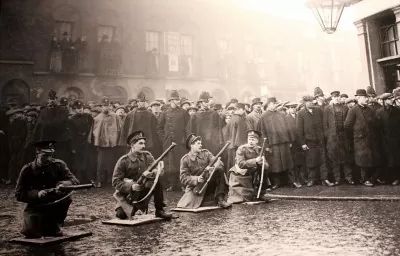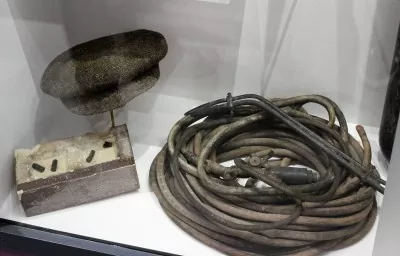THE CITY OF LONDON POLICE MUSEUM
- Sarah

- Jun 20, 2021
- 6 min read
Updated: Jan 2, 2023
Tucked away in an obscure corner of the magnificent London Guildhall, is the City of London Police Museum. Free to visit, this small museum tells the history of a unique police force which is responsible for law enforcement inside the Square Mile of central London - a mostly business district with few residents but huge amounts of daily workers.
UPDATE: AS OF 2023, THE MUSEUM HAS STILL NOT RE-OPENED AFTER THE PANDEMIC

The 'Square Mile' nickname for the City of London is something of a misnomer. It is based on the original Roman walls around Londinium, as although the Roman city was abandoned in the 5th century AD, it was resettled by Alfred the Great in the 9th century AD, and new walls were built on top of the foundations of the Roman walls. As the city grew in size and new districts were established, the city area increased to 1.05 square miles, with the name The Square Mile first being used by the Victorians in the 1860s. The city by then had become a centre of international banking, commerce and trade. Boundaries were altered again in 1994, and the Square Mile grew to an area of 1.12 miles.
The area still has many of its Medieval traditions of aldermen who represent each ward and form the governance of the city, presided over by the Mayor of London. It also has its own police force, who operate solely within this square mile and who were never subsumed into the wider London Metropolitan Police who cover everywhere else in the vast capital city.
The museum tells the history of this unique force and the specific issues that they have had to deal with over the past 175 years, which include Jack the Ripper, the Houndsditch Murders which is still one of the biggest multiple murders of on duty police officers, the bombings of the Blitz, and the latest threat of terrorism from both the IRA and religious fundamentalists. The City of London Police are experts in economic fraud and money laundering, due to their unique position policing so many banking institutions.

L: This book contains Watch-house day reports from 1833, recording who was on duty and what happened each day within Tower division, one of the wards inside the City of London.
The museum starts with the early days of the City police force. Before a formalised police force, there were several ways of policing the inhabitants of the city. ‘Watchmen’ were originally in place to defend the city’s walls from invaders, but by the 13th century they were tasked with policing inside the city walls. One man from each ward would take it in turns and would have to serve as a watchman for a year, this was the ‘watch and ward’ system which lasted until the 19th century.
In 1663 an Act was passed decreeing that there must be 1000 men on duty each night; they were knowns as ‘Charleys’ and were often the target of much ridicule as they were usually old men carrying handcuffs, a lantern and a stick. By 1784 a City Day Police was established, with better paid constables. The Metropolitan Police copied this model in 1829 to police all of London, but the City Police refused to be a part of it, formally establishing their own force in 1839, and they have retained their autonomy to this day.
L: The Home Secretary, Winston Churchill, brought in the Scots Guards in an attempt to capture the gang members
R: This 63 foot length of hose was used by the gang in the robbery. They attached it to a gas supply and attempted to feed it though to the jewellery shop to burn the safe. The cap also belonged to one of the gang members
The Houndsditch Murders, and the subsequent Sidney Street Siege, caused one of the biggest loses of life or injury of police officers on duty in the UK. It started in December 1910, when three police officers were killed and two more were injured, trying to prevent a robbery in a jewellers shop by a Latvian gang. After putting out a reward for information on the gang members, they were traced a few weeks later to a house in Sidney Street.
An armed siege followed, with the Scots Guards showing up, but the gang refused to surrender and they eventually died when the house caught fire. It was one of the first police actions caught on camera, as Pathe News were there to record it, and it led to national debates about immigration and the suitability of police weapons.

The WSPU were the militant arm of the Suffrage movement, who after decades of peaceful campaigning and still not winning the vote, decided on more militant actions, such as public disruption, window smashing and chaining themselves to railings. When that still didn’t force change, they increased their militancy and decided to up their game.
They carried out incendiary attacks on businesses, public places and important buildings, although never with loss of life. In the space of one year they carried out over 300 incidents of arson and bombing. The two bombs in the Police Museum were ones that had failed to detonate. The one on the left, made from a milk tin, was found outside the Bank of England, the day after Emmeline Pankhurst was jailed. The police were able to diffuse it before it went off.

The museum contains artefacts from both World War I and II, as many policemen joined the forces. In World War II, the City was a frequent target for bombing by the Luftwaffe, with thousands of incendiary bombs falling on the area during the Blitz.
All of the police stations received damage, but one, Moor Lane, was totally destroyed on one night in December when 100,000 bombs were dropped. All that remains is the clock in the display case. There is also a book which saved a policeman’s life, with shrapnel lodging in the book instead of him - both book and shrapnel are on display.
Police would carry hand lamps while on night patrol, covered with a blackout blind to ensure that the beam could not be seen by aircraft above. All police officers were trained in first aid and would carry small kits with them to help those injured. Many police officers received medals for their acts of courage during this time.
L: The top hat was originally worn by all the police officers, and was reinforced with cane so that they could also use it as a step when needed
R: Helmets replaced the hat in 1865 and were based on the shape and design of Greek helmets
The City of London Police wear different uniforms to those of their colleagues in the Metropolitan Police, and many are on display in the museum. Their first uniforms from 1840 were in blue, to differentiate them from the red coats of the army, and had a high leather collar, to prevent against being garroted, which was the most common way to attack police officers at the time. This changed after about 30 years, when helmets replaced their top hats, and they stopped wearing coat tails.

Today, the City of London police are distinguished by wearing red and white checks where the others wear black and white, and having brass badges and buttons instead of white metal. They also wear the City of London coat of arms on their helmets.
Blue police post boxes were once a common sight in London and were used for police to contact each other, or for the public to contact the police. The advent of two way radios saw them disappear from London’s streets.
Plenty of forged currency has passed through the hands of the City of London police force, some of which is on display in the museum.
The museum is a fascinating glimpse at the history and work of the force. It may be a small museum, but it is comprehensive and well worth a visit. It includes free audio guides for those that want one, and a trail for children.
The City of London Police Museum is one of a number of history museums in London that do not charge an entry fee >>
VISITING THE CITY OF LONDON POLICE MUSEUM
CURRENTLY CLOSED WITH NO DATE PROVIDED FOR RE-OPENING
Opening Hours
Monday – Friday 9.30 - 5pm
Some Saturdays 10am - 4pm (see website for dates)
Entrance is free
There are free guided tours of the museum at 1pm on the first Friday of every month. Book online through the Guildhall Library.
Use the Guildhall Library entrance, Aldermanbury, EC2V 7HH
You will have to have your bags checked before you can go in.












Comments